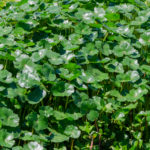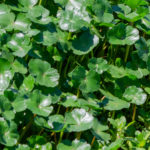Hydrocotyle ranunculoides
USDA, NRCS. 2018. The PLANTS Database (http://plants.usda.gov, 28 March 2018). National Plant Data Team, Greensboro, NC 27401-4901 USA.
Illustration: USDA-NRCS PLANTS Database / USDA NRCS. Wetland flora: Field office illustrated guide to plant species. USDA Natural Resources Conservation Service.
What is Floating Pennywort?
Physical Characteristics
Leaves:
- Roundish
- Up to 3.16 inches long & wide
- 5-6 lobes
- Slender leaf stalks
Flowers:
- Peduncles shorter than the leaves
- Grow in clusters
- Simple
- 5-10 flowers per cluster
- White or yellow in color
Fruit:
- Elliptical shaped
- 0.05-0.13 inches long
- 0.08-0.13 inches wide
Stem:
- Slender
- Creeping
Where Does it Grow?
EDDMapS. 2024. Early Detection & Distribution Mapping System. The University of Georgia – Center for Invasive Species and Ecosystem Health. Available online at http://www.eddmaps.org/; last accessed January 17, 2024.
Floating pennywort can be found in shallow pools and muddy shores.
Pros and Cons of Floating Pennywort
The seeds of pennywort are used occasionally as food by waterfowl. Submerged portions of all aquatic plants provide habitats for many micro and macro invertebrates. These invertebrates in turn are used as food by fish and other wildlife species (e.g. amphibians, reptiles, ducks, etc.). After aquatic plants die, their decomposition by bacteria and fungi provides food (called “detritus”) for many aquatic invertebrates.


